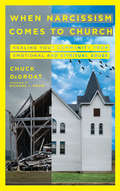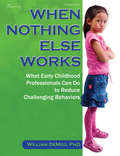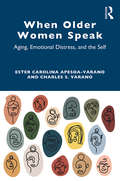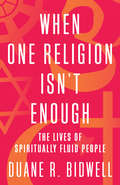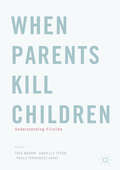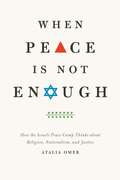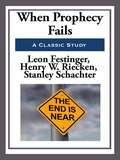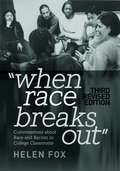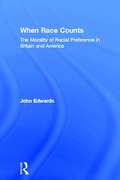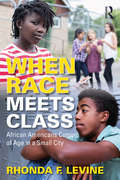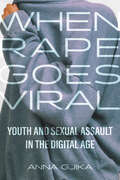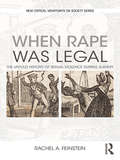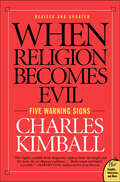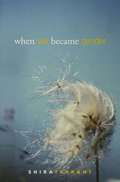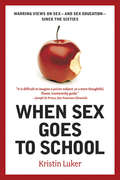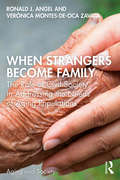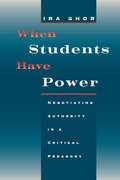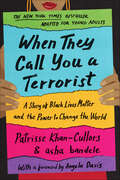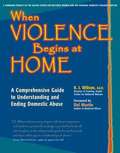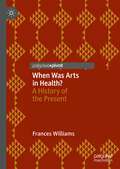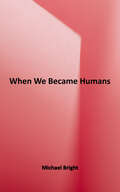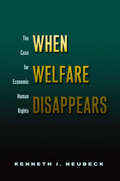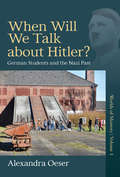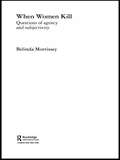- Table View
- List View
When Narcissism Comes to Church: Healing Your Community From Emotional and Spiritual Abuse
by Chuck DeGroatWhy does narcissism seem to thrive in our churches?isWhen Narcissism Comes to Church
When Nothing Else Works: What Early Childhood Professionals Can Do to Reduce Challenging Behaviors
by William DemeoResearch shows that children do not outgrow challenging behavior, making early intervention essential. But what can early childhood educators do to reduce challenging behaviors when nothing seems to work?From aromatherapy to affirmations, When Nothing Else Works is filled with creative strategies and techniques to address and adjust problematic behavior in the classroom while also promoting resilience and active engagement in learning. Written from the perspective of an experienced school development psychologist, William DeMeo builds upon the latest behavioral research and evidence-based practices.
When Older Women Speak: Aging, Emotional Distress, and the Self
by Charles S. Varano Ester Carolina Apesoa-VaranoStudying the interaction of gender, class, race/ethnicity, and aging in the depression experience of older women provides a unique opportunity to understand how aging plays a significant role in shaping conceptions of self and emotional health trajectories for women. Based on author interviews with mostly working-class, depressed, elderly women, this book contributes to the theoretical understanding of femininity and aging and the practical implications for policy and effective health care treatment. Cultivating an "alternative self" can reduce older women’s suffering and provide the emotional resources to change their inner worlds, even if the outer world stretches beyond their control. Depression affects women twice as often as men. Up to 40 percent of older adults respond poorly to depression treatment, and depression is linked to higher morbidity and mortality rates and cognitive decline. Older adults with depression have 50 percent higher health care costs, yet depression is accurately recognized in less than one half of older adults in primary care. While older men are more likely to die by suicide, older women are two to three times more likely to attempt suicide, and depression is the best predictor of suicide in older adults. Latina and African American women have lower rates of depression treatment compared to non-minority women. From issues of health care access to the stigma of depression, older Latinas and African American women are at an increased risk for untreated depression. This book seeks to address some of the significant gaps in our knowledge of late-life depression in women, especially in ethnic minorities, ranging from detection and efficacy of depression treatment to informal influences (e.g., family) on formal depression care seeking.
When One Religion Isn't Enough: The Lives of Spiritually Fluid People
by Duane R. BidwellAn exploration into the lives of people who embrace two or more religious traditions, and what this growing community tells us about change in our societyIn the United States, we often assume religious and spiritual identity are pure, static, and singular. But some people regularly cross religious boundaries. These "spiritually fluid" people celebrate complex religious bonds, and in the process they blur social categories, evoke prejudice, and complicate religious communities. Their presence sparks questions: How and why do people become spiritually fluid? Are they just confused or unable to commit? How do we make sense of them?When One Religion Isn't Enough explores the lives of spiritually fluid people, revealing that while some chose multiple religious belonging, many more inherit it. For many North Americans, the complicated legacies of colonialism are part of their family story, and they may consider themselves both Christian and Hindu, or Buddhist, or Yoruban, or one of the many other religions native to colonized lands.For some Asian Americans, singular religious identity may seem an alien concept, as many East Asian nations freely mix Buddhist, Confucian, Taoist, and other traditions. Some African American Christians are consciously seeking to reconnect with ancestral spiritualities. And still other people are born into religiously mixed families. Jewish-Christian intermarriage led the way in the US, but religious diversity here is only increasing: almost four in ten Americans (39 percent) who have married since 2010 have a spouse who is in a different religious group.Through in-depth conversations with spiritually fluid people, renowned scholar Duane Bidwell explores how people come to claim and be claimed by multiple religious traditions, how spiritually fluid people engage radically opposed truth claims, and what this growing population tells us about change within our communities.
When Parents Kill Children
by Thea Brown Danielle Tyson Paula Fernandez AriasThis edited collection addresses a substantial gap in the existing literature on filicide by presenting the latest research from empirical investigations around the world. Despite its low occurrence, little is known about the incidences, causes and circumstances of filicide nationally and globally, and this international volume address the challenges associated with explaining and understanding filicide. Additionally, the authors also outline the role of professionals in assessing risk, and the importance of support for, and advocacy of, families of victims in the aftermath of these tragic events. Exploring a truly diverse range of countries, from various English speaking countries, to Chile, and Japan, this book presents an authoritative look at research on filicide, and crucially, examines the programs currently being developed for both intervention and prevention. An important and well-researched collection, this book will be of particular interest for scholars of do mestic violence and filicide, as well as professionals such as social workers.
When Peace Is Not Enough: How the Israeli Peace Camp Thinks about Religion, Nationalism, and Justice
by Atalia OmerThe state of Israel is often spoken of as a haven for the Jewish people, a place rooted in the story of a nation dispersed, wandering the earth in search of their homeland. Born in adversity but purportedly nurtured by liberal ideals, Israel has never known peace, experiencing instead a state of constant war that has divided its population along the stark and seemingly unbreachable lines of dissent around the relationship between unrestricted citizenship and Jewish identity. aBy focusing on the perceptions and histories of IsraelOCOs most marginalized stakeholdersOCoPalestinian Israelis, Arab Jews, and non-Israeli JewsOCoAtalia Omer cuts to the heart of the Israeli-Arab conflict, demonstrating how these voices provide urgently needed resources for conflict analysis and peacebuilding. Navigating a complex set of arguments about ethnicity, boundaries, and peace, and offering a different approach to the renegotiation and reimagination of national identity and citizenship, Omer pushes the conversation beyond the bounds of the single narrative and toward a new and dynamic concept of justiceOCoone that offers the prospect of building a lasting peace.
When Prophecy Fails
by Stanley Schachter Leon FestingerThe study reported in this volume grew out of some theoretical work, one phase of which bore specifically on the behavior of individuals in social movements that made specific (and unfulfilled) prophecies. We had been forced to depend chiefly on historical records to judge the adequacy of our theoretical ideas until we by chance discovered the social movement that we report in this book. At the time we learned of it, the movement was in mid-career but the prophecy about which it was centered had not yet been disconfirmed. We were understandably eager to undertake a study that could test our theoretical ideas under natural conditions. That we were able to do this study was in great measure due to the support obtained through the Laboratory for Research in Social Relations of the University of Minnesota. This study is a project of the Laboratory and was carried out while we were all members of its staff. We should also like to acknowledge the help we received through a grant-in-aid from the Ford Foundation to one of the authors, a grant that made preliminary exploration of the field situation possible.
When Race Breaks Out: Conversations about Race and Racism in College Classrooms (3rd Revised Edition) (Higher Ed #29)
by Helen FoxThe third revised edition of "When Race Breaks Out" is a guide for college and high school teachers who want to promote honest and informed conversations about race and racism. Based on the author's personal practice and interviews with students and faculty from a variety of disciplines, this book combines personal memoirs, advice, teaching ideas, and lively classroom vignettes. A unique insider's guide to the salient ideas, definitions, and opinions about race helps instructors answer students' questions and anticipate their reactions, both to the material and to each other. An extensive annotated bibliography of articles, books, and videos with recommendations for classroom use is included.
When Race Counts: The Morality of Racial Preference in Britain and America
by John EdwardsWhen Race Counts investigates the use of race-conscious practices in social policy in Britain and America. It questions the distinction between affirmative action and preferential treatment, and evaluates the effectiveness of a range of education and employment policies designed to counteract both unintended and direct discrimination against ethnic minorities. The book uses both empirical and moral analyses to examine the controversial dilemma of whether and in what circumstances preferential treatment may be used as a means of improving the condition of minority groups. John Edwards looks at justifications for overriding the merit principle, particularly in employment, and shows who bears the costs of such a policy, and where the benefits lie. He argues that the merit principle is in itself so flawed that to override it would cause no great damange to justice. He then sets out the requirements of an acceptable policy of minority preference tailored to the disadvantages of specific minority groups.
When Race Meets Class: African Americans Coming of Age in a Small City
by Rhonda F. LevineA rare, 15-year ethnography, this book follows the lives of individual, low-income African American youth from the beginning of high school into their early adult years. Levine shows how their interaction and experience with multiple institutions (family, school, community) and individuals (parents, friends, teachers, coaches, strangers) shape their hopes, fears, aspirations, and worldviews. The intersectionality of their social identities—how race, class, and gender come together to influence how they come to think about who they are—influences many behaviors that directly contradict their stated aspirations. Affected, too, by limited access to resources, these youths often take a path profoundly different from their stated values and life goals. Levine explores the volatility and constraints underlying their decision-making and behaviors. The book reveals the critical junctures and turning points shaping life trajectories, challenging many long-held assumptions about the persistence of racial inequality by offering new insights on the educational and occupational barriers facing young African Americans.
When Rape Goes Viral: Youth and Sexual Assault in the Digital Age
by Anna GjikaStories of teen sexting scandals, cyberbullying, and image-based sexual abuse have become commonplace fixtures of the digital age, with many adults struggling to identify ways to monitor young people's digital engagement. In When Rape Goes Viral, Anna Gjika argues that rather than focusing on surveillance, we should examine such incidents for what they tell us about youth peer cultures and the gender norms and sexual ethics governing their interactions. Drawing from interviews with teens and high-profile cases of mediated juvenile sexual assault, Gjika exposes the deeply unequal and heteronormative power dynamics informing teens' intimate relationships and online practices, and she critically interrogates the role of digital cultures and broader social values in sanctioning abuse. The book also explores the consequences of social media and digital evidence for young victim-survivors and perpetrators of sexual assault, detailing the paradoxical capacities of technology for social and legal responses to gender-based violence.
When Rape was Legal: The Untold History of Sexual Violence during Slavery (New Critical Viewpoints on Society)
by Rachel A. FeinsteinWhen Rape was Legal is the first book to solely focus on the widespread rape perpetrated against enslaved black women by white men in the United States. The routine practice of sexual violence against enslaved black women by white men, the motivations for this rape, and the legal context that enabled this violence are all explored and scrutinized. Enlightening analysis found that rape was not merely a result of sexual desire and opportunity, or simply a form of punishment and racial domination, but instead encompassed all of these dimensions as part of the identity of white masculinity. This provocative text highlights the significant role that white women played in enabling sexual violence against enslaved black women through a variety of responses and, at times, through their lack of response to the actions of the white men in their lives. Significantly, this book finds that sexual violence against enslaved black women was a widespread form of oppression used to perform white masculinity and reinforce an intersectional hierarchy. Additionally, white women played a vital role by enabling this sexual violence and perpetuating the subordination of themselves and those subordinate to them.
When Religion Becomes Evil: Five Warning Signs (Plus Ser.)
by Charles KimballIn this thoroughly revised and updated edition, leading religion and Middle East expert Charles Kimball shows how all religious traditions are susceptible to these basic corruptions and why only authentic faith can prevent such evil.The Five Warning Signs of Corruption in Religion1. Absolute Truth Claims2. Blind Obedience3. Establishing the "Ideal" Time4. The End Justifies Any Means5. Declaring Holy War
When Sex Became Gender (Perspectives On Gender Ser.)
by Shira TarrantWhen Sex Became Gender is a study of post-World War II feminist theory from the viewpoint of intellectual history. The key theme is that ideas about the social construction of gender have its origins in the feminist theorists of the postwar period, and that these early ideas about gender became a key foundational paradigm for both second and third wave feminist thought. These conceptual foundations were created by a cohort of extraordinarily imaginative and bold academic women. While discussing the famous feminist scholars—Simone de Beauvoir, Margaret Mead—the book also hinges on the work of scholars who are lesser known to American audiences—Mirra Komarovsky, Viola Klein, and Ruth Herschberger, The postwar years have been an overlooked period in the development of feminist theory and philosophy and Tarrant makes a compelling case for this era being the turning point in the study of gender.
When Sex Goes to School: Warring Views on Sex--and Sex Education--Since the Sixties
by Kristin Luker"It is difficult to imagine a juicier subject, or a more thoughtful, fluent, trustworthy guide for its exploration."--San Francisco Chronicle A chronicle of the two decades that noted sociologist Kristin Luker spent following parents in four America communities engaged in a passionate war of ideas and values, When Sex Goes to School explores a conflict with stakes that are deceptively simple and painfully personal. For these parents, the question of how their children should be taught about sex cuts far deeper than politics, religion, or even friendship. "The drama of this book comes from watching the exceptionally thoughtful Luker try to figure [sex education] out" (Judith Shulevitz, New York Times Book Review). In doing so, Luker also traces the origins of sex education from the turn-of-the-century hygienist movement to the marriage-obsessed 1950s and the sexual and gender upheavals of the 1960s. Her unexpected conclusions make it impossible to look at the intersections of the private and the political in the same way.
When Strangers Become Family: The Role of Civil Society in Addressing the Needs of Aging Populations (Aging and Society)
by Ronald J. Angel Verónica Montes-de-Oca ZavalaAs the 21st Century unfolds, the traditional welfare state that evolved during the 20th Century faces serious threats to the solidarity that social programs were meant to strengthen. The rise of populist and nationalist parties reflects the decline of a sense of belonging and inclusiveness that mass education and economic progress were meant to foster, as traditional politics and parties are rejected by working- and middle-class individuals who were previously their staunchest supporters. Increasingly, these groups reject the growing gaps in income, power, and privilege that they perceive between themselves and highly educated and cosmopolitan business, academic, and political elites. When Strangers Become Family examines the potential role of civil society organizations in guaranteeing the rights and addressing the needs of vulnerable groups, paying particular attention to their role in advocacy for and service delivery to older people. The book includes a discussion of the origins and functions of this sector that focuses on the relationship between the state and non-governmental organizations, as well as a close examination of Mexico – a middle-income nation with a rapidly aging population and limited state welfare for older people. The data reveals important aspects of the relationship among government actors, civil society organizations, and political parties. Ronald Angel and Verónica Montes-de-Oca Zavala ask the fundamental question about the extent to which civil society organizations represent a potential mechanism whereby vulnerable individuals can join together to further their own interests and exercise their individual and group autonomy.
When Students Have Power: Negotiating Authority in a Critical Pedagogy
by Ira ShorWhat happens when teachers share power with students? In this profound book, Ira Shor—the inventor of critical pedagogy in the United States—relates the story of an experiment that nearly went out of control. Shor provides the reader with a reenactment of one semester that shows what really can happen when one applies the theory and democratizes the classroom. This is the story of one class in which Shor tried to fully share with his students control of the curriculum and of the classroom. After twenty years of practicing critical teaching, he unexpectedly found himself faced with a student uprising that threatened the very possibility of learning. How Shor resolves these problems, while remaining true to his commitment to power-sharing and radical pedagogy, is the crux of the book. Unconventional in both form and substance, this deeply personal work weaves together student voices and thick descriptions of classroom experience with pedagogical theory to illuminate the power relations that must be negotiated if true learning is to take place.
When Tenants Claimed the City: The Struggle for Citizenship in New York City Housing
by Roberta GoldIn postwar America, not everyone wanted to move out of the city and into the suburbs. For decades before World War II, New York's tenants had organized to secure renters' rights. After the war, tenant activists raised the stakes by challenging the newly-dominant ideal of homeownership in racially segregated suburbs. They insisted that renters as well as owners had rights to stable, well-maintained homes, and they proposed that racially diverse urban communities held a right to remain in place--a right that outweighed owners' rights to raise rents, redevelop properties, or exclude tenants of color. Further, the activists asserted that women could participate fully in the political arenas where these matters were decided. Grounded in archival research and oral history, When Tenants Claimed the City: The Struggle for Citizenship in New York City Housing shows that New York City's tenant movement made a significant claim to citizenship rights that came to accrue, both ideologically and legally, to homeownership in postwar America. Roberta Gold emphasizes the centrality of housing to the racial and class reorganization of the city after the war; the prominent role of women within the tenant movement; and their fostering of a concept of "community rights" grounded in their experience of living together in heterogeneous urban neighborhoods.
When They Call You a Terrorist (Young Adult Edition): A Story of Black Lives Matter and the Power to Change the World
by Asha Bandele Patrisse Khan-CullorsPatrisse Khan-Cullors' and asha bandele's instant New York Times bestseller, When They Call You a Terrorist is now adapted for the YA audience with photos and journal entries!A movement that started with a hashtag--#BlackLivesMatter--on Twitter spread across the nation and then across the world.From one of the co-founders of the Black Lives Matter movement comes a poetic memoir and reflection on humanity. Necessary and timely, Patrisse Khan-Cullors’ story asks us to remember that protest in the interest of the most vulnerable comes from love. Leaders of the Black Lives Matter movement have been called terrorists, a threat to America. But in truth, they are loving women whose life experiences have led them to seek justice for those victimized by the powerful. In this meaningful, empowering account of survival, strength, and resilience, Cullors and asha bandele seek to change the culture that declares innocent black life expendable.
When Violence Begins at Home: A Comprehensive Guide to Understanding and Ending Domestic Abuse
by K. J. WilsonSince its initial publication, this far-reaching reference has provided professionals and victims of abuse with guidance on everything from indicators of an abusive relationship to domestic violence legislation, from antiburnout tips for helpers to advice on leaving an abusive partner. This updated edition addresses new research and programs, adding information on date rape drugs, stalking, cyber-stalking, pregnancy and domestic violence, and the effectiveness of batterer intervention programs. Current controversial social and legal issues such as mutual battering, child welfare and "failure to protect" policies, child custody and visitation rights for batterers, mandatory arrests, and welfare reform are also covered. Two new chapters devote attention to domestic violence in the military and to the challenging and rewarding role of those who work with battered women and their children. New resources have been included to reflect the ever-evolving wealth of books, web sites, and agencies available to both helpers and those in need.
When Was Arts in Health?: A History of the Present
by Frances WilliamsThis book critically appraises the field of Arts in Health in the light of the recent public health crisis and so-called culture wars. A new term was coined in Britain in 2017 for this area of work by an All-Party Parliamentary Group: “creative health”. Williams sets this hopeful assertion against a darker backdrop of austerity, rising inequality and “Covid-nationalism”. Understandings of the field as a (multi)national phenomenon are examined through contested narratives that surround its origin. Using genealogical methods, Williams shows how at supra, national and local policy levels, Arts in Health is presented as an idea that transcends place and time. Arguing against this premise, post-war decades are examined to reveal hidden, mutable arts-health expressions. Examples of practice, and their recognition as such, are context dependent it is concluded – produced by political economies as well as oppositional social movements.
When We Became Humans: Our Incredible Evolutionary Journey (Incredible Evolution Ser. #2)
by Michael BrightWhat makes us human, and where did we come from? How did a clever ape climb down from the trees and change the world like no other animal has done before? This large-format, highly illustrated book guides readers through the key aspects of the human story, from the anatomical changes that allowed us to walk upright and increased brain size in our ancestors, to the social, cultural, and economic developments of our more recent cousins and our own species. Along the way, focus spreads take a closer look at some of the key species in our history, from the ancient Australopithecus Afarensis, 'Lucy', to our recent cousins the Neanderthals, and ourselves, Homo sapiens. Looking beyond the anatomical evolution of humans, this book explores how our culture and way of living has evolved, from how trails of cowry shells reveal early trade between tribes, to how and why humans first domesticated dogs, horses, and farm animals, and began settling in permanent villages and cities. Through digestible information and absorbing illustration, young readers will be given an insight into their origins, and what it means to be a human.
When Welfare Disappears: The Case for Economic Human Rights
by Kenneth J. NeubeckThis groundbreaking new book offers a history of welfare, an accurate portrayal of welfare recipients and an understanding of the diverse characteristics of lone-mother-headed families affected by welfare reform. Through detailed research, award-winning author Kenneth J. Neubeck offers a unique comparison of other industrialized nation's welfare policies compared to ours, and presents a new argument for curtailing the end of welfare as we know it: the case for respecting economic human rights.
When Will We Talk About Hitler?: German Students and the Nazi Past (Worlds of Memory #1)
by Alexandra OeserFor more than half a century, discourses on the Nazi past have powerfully shaped German social and cultural policy. Specifically, an institutional determination not to forget has expressed a “duty of remembrance” through commemorative activities and educational curricula. But as the horrors of the Third Reich retreat ever further from living memory, what do new generations of Germans actually think about this past? Combining observation, interviews, and archival research, this book provides a rich survey of the perspectives and experiences of German adolescents from diverse backgrounds, revealing the extent to which social, economic, and cultural factors have conditioned how they view representations of Germany’s complex history.
When Women Kill: Questions of Agency and Subjectivity (Transformations)
by Belinda MorrisseyWhy are we so reluctant to believe that women can mean to kill? Based on case-studies from the US, UK and Australia, this book looks at the ways in which female killers are constructed in the media, in law and in feminist discourse almost invariably as victims rather than actors in the crimes they commit. Morrissey argues that by denying the possibility of female agency in crimes of torture, rape and murder, feminist theorists are, with the best of intentions, actually denying women the full freedom to be human. Case studies cover among others the battered wife, Pamela Sainsbury, who garrotted her husband as he slept, the serial killer, Aileen Wournos, who killed seven middle-aged men in Florida between 1989 and 1990, Tracey Wiggington, the so-called "lesbian vampire killer", and Karla Homolka who helped her husband kill two teenage girls in St. Catherines Ontario in 1993.
